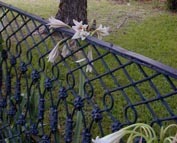Radcliffeborough Neighborhood Association
Our Information
- Contact List
- Our contact information...
- Newsletter Archive
- Previous Newsletters...
About Us

The History of Radcliffeborough
Radcliffeborough began as farmland purchased and surveyed by Thomas Radcliffe in 1786. Thomas’ estate and his widow, Lucretia continued to develop the borough after Thomas was lost at sea in 1806.
In 1811, the Third Episcopal Church was built on four lots donated by Mrs. Radcliffe for this purpose. St. Paul’s convenient local and grand appearance attracted rice planters from the neck to worship alongside homes built by merchants and mechanics, several free black families (from before the Civil War) as well as slaves living apart from their masters and after the war, newly freed slaves.
The Lay of the Land
Today, Radcliffeborough is as racially and economically mixed as it was then but its boundaries have grown from its original eight blocks to span from King Street to Ashley Avenue and from Bee Street, to Calhoun. It's topography has changed as well and would seem incredibly different to Thomas Radcliffe. In his time and even up to 1846, Calhoun Street did not exist. The area that would eventually become Calhoun was a millpond and Comings Creek ran through the land where the Cathedral of St. Paul now stands.
Architecture
While the Cathedral was the first, and largest edifice built in Radcliffeborough, many other interesting churches and houses exist within its boundaries as well.
Some of note are:
The Central Baptist Church at 26 Radcliffe Street, built in 1891 and designed by John P. Hutchinson, a black architect. The interior contains murals painted in 1912-1915 by the artist Amohamed Milai of Calcutta, lndia.
The Old Bethel Methodist Church on Calhoun is the oldest Methodist church in the Lowcountry and perhaps in South Carolina. The pulpit is said to have been used in 1798 by Francis Asbury, the first Methodist bishop in the United States while he visited Charleston.
Ashley Hall at 172 Rutledge Avenue was originally built by Patrick Duncan, a wealthy tallow chandler sometime between 1802 and 1816. After passing hands a few times, it became Ashley Hall, a private school for girls in 1909.
Number 57 Radcliffe built in 1817, and 64-66 Warren built in 1816 are believed to be the two oldest houses in the borough. Referred to as the "West Indian House", historians have put forth various theories to explain the architecture and history of 57 Radcliffe but not much factual history has been discovered about it.
In contrast, more is known about the house at 64-66 Warren. James Gabeau, a cooper and descendant of French Huguenot immigrants built the plantation style home. It was one of the first substantial dwellings built in the borough.
The U.S. Arsenal/Old Porter Military Complex at 167 Ashley Avenue was sold to the Medical University of South Carolina when the Porter Military Academy moved campus to merge with another school but three of the buildings remain. Colcock Hall, (the two-story brick artillery building used in 1862-64 by the Confederacy), Hoffman Library (a Gothic Revival Library designed by New York architect J.B. Snooks) and St. Timothy's Chapel (now St. Luke's have all been carefully restored by the Medical University.
Take a walk through Radcliffeborough and enjoy our architecture, our gardens and our shops on King Street, but talk to our people. They have the stories behind all the bricks, wood and dirt that have been molded, shaped and moved over the centuries. If you look close, around the smiles, between the wrinkles, you will find the character that has made us dig in, remain and rebuild after decades of raging fires, shattering earthquakes and devastating hurricanes.


